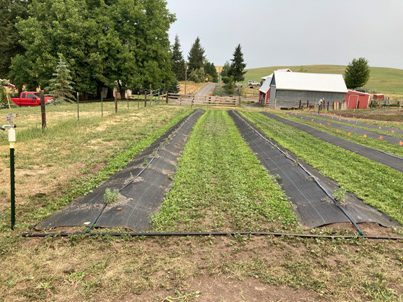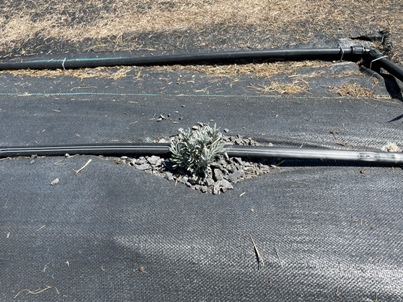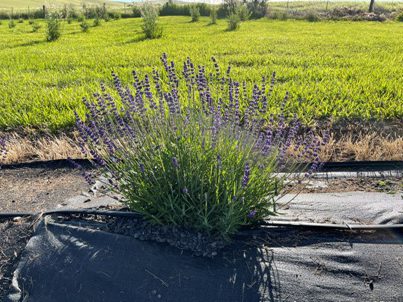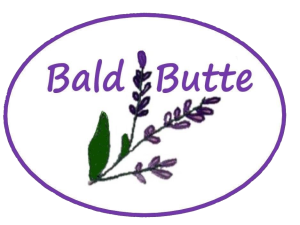Post-Planting Lavender Care
Watering
During their first growing season young lavender plants should be well watered to encourage good root development prior to winter dormancy. In the hot summer months water several times per week based on plant and garden conditions. For example, in the Palouse region of southeastern Washington we water every 2nd or 3rd day during our long hot dry summers. You should always water from below. Our farm uses a drip tape irrigation system. Watering from above can lead to fungal disease, plants that splay open in the center, and greater weed growth. Once lavender is more established in the 2nd or 3rd year the plants are fairly drought tolerant and don’t need frequent watering. Plants, however, should be deeply watered once every week or two weeks depending on dryness, when flowering to increase quality and yield, and following harvest to increase shoot growth and stimulate more flowering stems for next season. Watering should be stopped in September to promote hardening prior to the onset of winter. Remember, lavender thrive in well-drained soils and do not like their roots in standing water which can lead to root rot.


Fertilizing
Lavender thrives in low to moderately fertile soils, and therefore, should require little or no fertilization. However, closely monitor your plant’s health, and if needed, fertilize following the manufacturer’s instructions. Over-fertilized lavender tend to have fewer flower blooms and greater vegetative growth. In addition, lavender that is over-fertilized and over-watered has less intense fragrance, reduced oil quality, and diminished plant health. Both fertilizing and watering should be stopped in September to promote lavender hardening prior to the onset of winter, and lessen the occurrence of winter damage and mortality.
Weeding
Harvesting
Lavender should be harvested between mid-morning and early afternoon, and not when the plants are wet from morning dew, rain, or during the hottest part of the day. A harvest early in the growing season promotes air circulation, new branch growth and a second bloom later in the summer. Harvest timing depends on your management objective and lavender cultivar. We harvest at the first sign of flowering (10-20%) to maximize the amount of essential oils in the culinary buds while enhancing bud retention in dried bundles. Other management objectives include harvesting for craft buds (<50%), and production of essential oils (50-100%). When harvesting flowers you should cut low enough to get long flower stems leaving about 2 inches of green foliage above the woody stems. This first harvest, which produces long flower stems, also serves as a heavy pruning. If plants are harvested near or at full flowering this will lessen the chance of a second bloom.
Pruning
Between late August and early September, lavender plants not previously harvested/pruned should get a heavy pruning in preparation for winter. This pruning should occur at least 6 weeks prior to the first freezing temperatures. Stems should be cut leaving 2 inches of green foliage above the woody stems. Dead and low hanging branches should be cut to promote better air circulation and prevent disease. This pruning should result in a mound shaped crown which helps prevent winter damage. In addition, those previously harvested/pruned lavender plants should receive a trimming to remove second blooms, dead and low hanging branches, and create a mound shaped crown.
Some lavender growers prefer pruning in the spring, while the plant is still in winter dormancy or once green growth is noticed, but prior to bud formation. Whether you prune in the spring, fall, or during harvest, an annual pruning is essential for maintaining long-term lavender health and vigor. The annual pruning slows down woody stem growth, promotes new stem growth next spring producing better foliage and flowering, and maintains a dense mounded form.
Even when everything is done correctly the unexpected can happen. Lavender does well when the weather cooperates, but losing plants following harsh winters or delaying the onset of flowering during cold wet springs is not uncommon.


